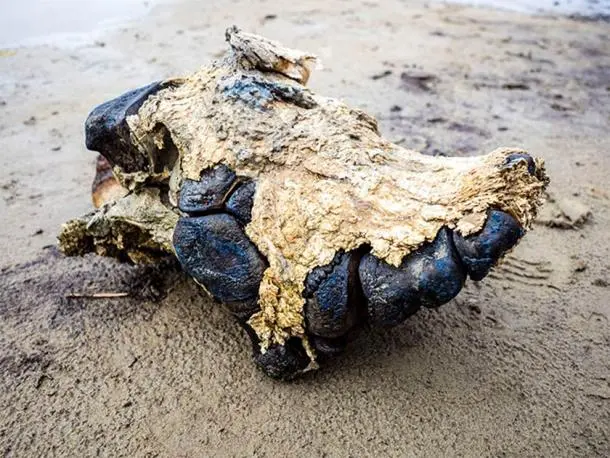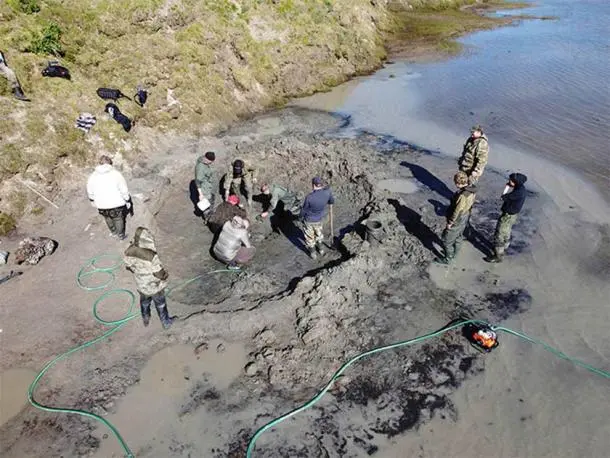A perfectly preserved mammoth has been discovered in a prehistoric ice sinkhole in Siberia.
Russian scientists have recovered the almost complete remains of a woolly mammoth in Russia. The remains of the Siberian mammoth are so well preserved that they still have flesh and hair. These remains are up to 10,000 years old and could play an important role in the international race to recreate prehistoric animals in laboratories. The remains of a prehistoric creature were found not far from the village of Seyakha.

The find was first discovered by members of a local indigenous community at Lake Pechenelava on the Yamal Peninsula. Siberia has been unusually warm this summer with massive wildfires raging in many areas of this remote and vast region. However, the warm weather also allowed the Siberian mammoth remains to be released from the permafrost.
The remains of a 10,000-year-old Siberian mammoth are almost perfect
Experts from the Arctic Scientific Centre for Studies arrived at the site where the mammoth remains were found and began an investigation. They managed to recover 90% of the mammoth’s remains, making it a spectacular discovery. The Daily Mail reports that the animal will be named “Tadibe after its finder Konstantin Tadibe, a reindeer herder who lives near the lake where the mammoth was found.”
Initial investigations have revealed that the mammoth was a 10-foot-tall male adolescent that died around 10,000 years ago. Evgenia Khozyainova, who took part in the study, said: “We have a well-preserved front and back leg, with tendons, soft tissue and pieces of skin,” according to the Daily Mail. The creature’s sacrum, some vertebrae and most of its tail, complete with pieces of skin and muscle, were also found. Archaeologist Andrey Gusev told The Siberian Times: “We managed to extract part of the skeleton, another part is still under water and is clay.”

Evidence suggests the mammoth died of natural causes
The mammoth remains removed from the watery shore of the lake were safely stored in a special refrigeration unit. Unfortunately, the animal’s brain was not preserved, which was a disappointment. The Siberian Times states that “only one brain found in 2014 in Yakutia in a woolly mammoth named Yuka has been preserved so far.” Furthermore, no tusks were recovered from the recent find. They could have been taken by humans or simply fallen off.
There is no evidence to suggest that the mammoth was killed by prehistoric hunters. Although marks on the bones indicate that at some point the remains of the prehistoric creature were scavenged. Dr Pavel Kosintsev speculates that “the mammoth may have become trapped in an ice crevasse and been unable to escape,” the Daily Mail reports.

The soft tissues of this ancient mammoth are perfect for cloning
It is extremely rare to find so many bones from one animal. A fossilised dung, known as coprolite, was also found. The Daily Mail quotes Dmitry Frolov of the Arctic Research Centre as saying that “the coprolite was left by this very mammoth.” This discovery may provide scientists with considerable details about the extinct mammoth’s feeding habits.
However, this astonishing find is particularly important because it provides superbly preserved dead mammoth DNA that can be used in cloning experiments. Teams from Russia, the United States, Japan and South Korea are desperately trying to clone ancient animals in test tubes. The soft tissue found at Tadibe could provide the DNA key for researchers to bring woolly mammoths back to life, just like in the movie Jurassic Park . The Russian federal government has funded a laboratory in Siberia to help them win the race to clone a mammoth, which has become a matter of national prestige.

Mammoth Graveyard
Mammoths once roamed much of Eurasia. They are closely related to modern elephants, but were twice the size. They had remarkable tusks and trunks that could pick up even small objects. These creatures had long woolly coats that allowed them to survive in the Arctic and were herbivores. Mammoths were hunted by humans and it is thought that overhunting along with climate change contributed to the extinction of these tundra giants, around 4,000 years ago.
The world’s most complete and best-preserved mammoth, nicknamed Lyuba, was also discovered on the Yamal Peninsula in 2007. Experts hope the lake and its surroundings will reveal many more ancient remains. They believe that, like Tadibe, other woolly elephants died here and were forever preserved in the permafrost. There could be a mammoth graveyard hidden in the silt and water, waiting to be found.






